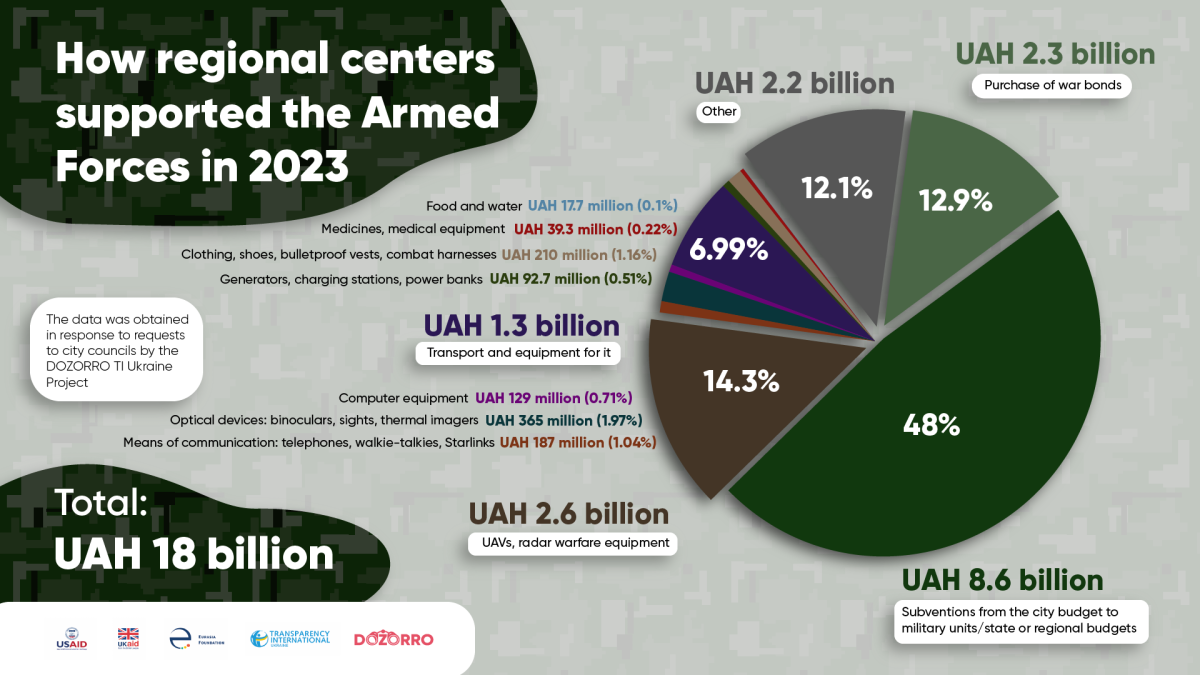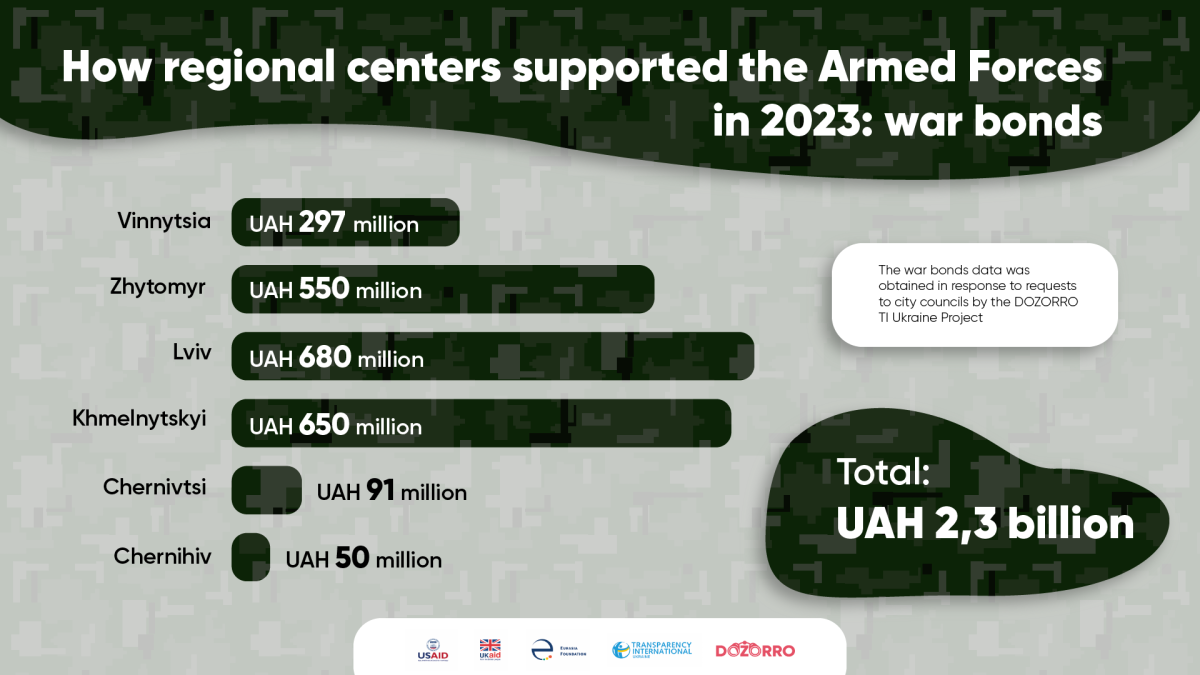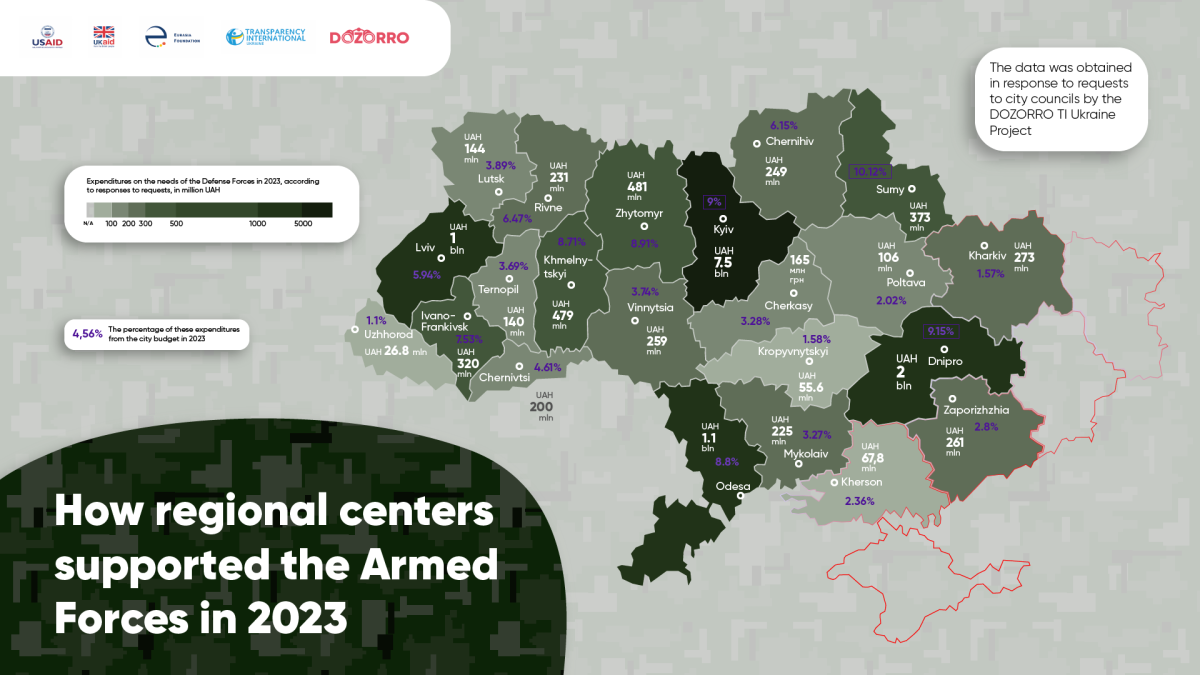

In general, defense spending is a responsibility of the state budget. However, this doesn’t mean that local authorities should stay uninvolved, as the needs in the fight against Russia are enormous. They can help the Armed Forces. Citizens expect and actively demand such assistance from their local officials, especially following last year’s scandals involving questionable tenders.
We tried to discover how regional centers supported the Defense Forces in 2023. The keyword is “tried,” as it turned out that obtaining structured and clear data from each city remains a challenge. To find out the results, keep reading.
How can cities allocate funds to support the military?
Firstly, cities can transfer funds directly from the local budget to the state budget’s special account for national security needs or to a specific military unit or division. That is, make subventions.
They may provide volunteer formations of a territorial community (VFTC), that is not the same as territorial defense forces. Cities also purchase and transfer military goods, such as drones, bulletproof vests, cars, and walkie-talkies, although the legality of such expenses may be questioned. After all, local governments do not have direct authority to allocate funds for defense – something MPs are aiming to address with draft law 9559-d.
Another way is to buy war bonds. In fact, this means borrowing money to the state budget. For now, the state will use these funds for defense and later return them to the community with interest.
There is also an option to pay funds to mobilized residents of the community. Indirect ways include repairing hospitals where military personnel recuperate, financing programs to support veterans’ businesses, or funding psychological rehabilitation. We excluded these expenses from the overall statistics (where identified) since, although related to the war, they pertain to rear support.
Most of all, regional centers use subventions
We requested data from regional centers on their 2023 expenditures to support the Defense Forces across various categories. Therefore, we provided them with a table to fill in expenses for categories such as optical devices, transport, clothing, medicines, and drones. Not all cities filled it. Some did it partially. Some also included additional expenses they deemed necessary, such as constructing shelters or eliminating of the consequences of shelling. We excluded such irrelevant data from our comparison to ensure accuracy. Therefore, we manually selected the relevant data from the requests to focus on what we had specifically asked for. While this data may not be perfectly accurate, it represents the best information we were able to obtain.
According to responses from regional centers, their total expenditures on supporting the Defense Forces in 2023 amounted to UAH 18 billion. The majority of their expenditures, 48% of defense spending (UAH 8.6 billion), came from subventions, which are transfers of funds to other budgets or military units. The second and third largest categories were UAVs and radar equipment, each accounting for approximately 14% (UAH 2.6 billion), followed closely by the purchase of war bonds at 13% (UAH 2.3 billion). Another 12% of the expenses were categorized as Other.
According to the responses of city councils, only 6 regional centers bought war bonds: Lviv, Khmelnytskyi, Zhytomyr, Vinnytsia, Chernivtsi, and Chernihiv. Furthermore, we will not include these amounts in the statistics for individual cities, as the funds loaned to the state will be returned to the communities – and in some cases, have already been returned.
In 2023, as a percentage of local budget expenditures, the city councils of Sumy allocated the most to financing the defense sector at 10.1%, followed by Dnipro at 9.2%, Kyiv at 9%, Zhytomyr at 8.9%, Odesa at 8.8%, Khmelnytskyi at 8.7%, and Ivano-Frankivsk at 7.5%. For comparison, we sourced information on total budget expenditures from the Openbudget resource.
In absolute numbers, Kyiv allocated the most at 7.5 billion UAH, followed by Dnipro at 2 billion UAH, Odesa at 1.1 billion UAH, and Lviv at 1 billion UAH for supporting the army.
Additionally, cities provided the military with items already on their balance sheets. According to their responses, the value of such assistance last year was approximately UAH 250 million.
Next, we will tell you more about the cities that contributed the most to supporting the Armed Forces of Ukraine.
Kyiv
Kyiv’s response was particularly confusing; it included many additional information but covered only 9 months of the year. In the Other column, data for 2022-2023 was included for some reason, so we did not include it in the total amount. If we add up the other expenses from the city council’s letter, for the first 9 months of 2023, the city allocated UAH 7.5 billion to support the Defense Forces. This is 9% of the total amount of budget expenditures. However, in January 2024, Mayor Vitali Klitschko stated that the assistance provided to the military for the year amounted to UAH 7 billion. It’s unclear how the spending for 9 months could surpass the annual amount. We reached out to the city council for clarification on this point but had not received a response by the time of publication.
According to the official response to the first request, most of the expenses were allocated as follows: UAVs and radar equipment at UAH 1.5 billion, subventions from the city budget at UAH 1.4 billion, repair and restoration of equipment at UAH 1 billion, and vehicles at UAH 900 million.
We did not include UAH 395 million in the total amount, as these were subventions to the state budget for ensuring readiness as a territorial subsystem of Kyiv’s Unified State Civil Protection System.
Dnipro
The city allocated UAH 2 billion for measures to defend against and counter Russia’s armed aggression. This is 9.2% of the total amount of budget expenditures. Of this amount, UAH 300 million was spent as a subvention, with an equal sum allocated for the purchase of drones and radar warfare equipment. UAH 70 million was allocated for radio stations and satellite equipment, including telephones, walkie-talkies, and Starlink systems.
We did not include UAH 448 million in the total amount, as indicated by the Dnipro City Council’s response, which was allocated for shelter arrangements and the restoration of facilities affected by missile attacks.
Odesa
The city’s expenses to support the Defense Forces amounted to UAH 1.1 billion, accounting for 8.8% of the community’s total expenses in 2023. More than two-thirds of the funds, UAH 800 million, were allocated as subventions to military units. An additional UAH 148 million was allocated for vehicles, including boats, UAH 11 million for medicines and medical equipment, and UAH 10 million for field bath and laundry complexes.
Lviv
In 2023, the city budget allocated over UAH 1 billion, which represents 6%. The city transferred part of the funds through subventions to military units, the police, the border guard service, the SSU, and the Main Directorate of Intelligence. Additionally, the city independently spent UAH 368 million on the purchase of UAVs, vehicles, and fuel, Starlink systems, generators, and other goods.
The city also reported spending UAH 199 million on repairing premises for various departments treating and rehabilitating the wounded, as well as setting up Military Rehabilitation Centers. These projects also raise funds from international partners, Twin Cities, and foundations. Basically, the city’s contribution is 20-30%. UAH 9.3 million was allocated for the establishment of the Administrative Service Center for veterans, a joint project with the Ministry of Veterans Affairs of Ukraine. The city council also mentioned other expenses related to the military, such as social payments and the socio-cultural program “Healing City” aimed at the rehabilitation of the military.
Zhytomyr
The city allocated UAH 480.7 million, which accounts for 8.9% of its expenses last year, to Security Forces. Specifically, the subvention to the Security and Defense Forces amounted to nearly UAH 300 million, while the acquisition of property totaled UAH 180.8 million. Among them, the largest share, UAH 143 million, was allocated for UAVs and radar equipment. The second largest category is transport and auxiliary equipment, totaling UAH 22.3 million.
Khmelnytskyi
Combining the data from the city council’s response with our classification, we find a total of UAH 479 million, which is 8.7%. The majority of these funds, UAH 390 million, are allocated for subventions and support to military units and law enforcement agencies. And UAH 60.5 million was spent on drones and radar equipment.
The city also reported nearly UAH 400 million in expenses for other events not listed in our table. That included:
- reconciliation of community’s “military personal income tax” – UAH 237.3
- social activities – UAH 82.6 million
- exemption from mandatory payments to the community budget and their allocation to defense needs – UAH 72.6 million.
However, the response does not clarify why the reconciliation of personal income tax is not considered a subvention, or how payments not collected within the community can be directed to defense.
Sumy
According to the response to the request, the city allocated UAH 372.7 million to the needs of the Defense Forces in 2023. That is 10.1% of the total city expenditures. The largest allocation, UAH 199.3 million, is directed towards supporting members of volunteer community formations and public non-military organizations. The subvention amounted to UAH 110.5 million, with an additional UAH 62.9 million allocated for territorial defense activities and works.
An additional UAH 23.1 million was allocated to territorial defense for addressing social and household issues. We have excluded these expenses.
Ivano-Frankivsk
The city allocated UAH 320 million to the Defense Forces, accounting for 7.5% of all expenses. In particular, the subvention to military units was UAH 57 million, and the cost of drones was UAH 30 million. The city allocated an additional UAH 214 million for other expenses, without specifying which ones.
Based on the data provided by regional centers in response to our request, last year they allocated between 1% and 11% of their budget expenditures to supporting the Defense Forces. For a quarter of the leading cities, this figure ranged from 6%. However, as the varied responses to the same questions have shown, focusing solely on numbers is not the most effective approach. Communities’ local self-government interpretations of allocating funds to support the Armed Forces of Ukraine vary, even when provided with a standardized form to fill out. Additionally, there’s always a temptation to include peripheral expenses to inflate the total amount. Therefore, it’s crucial for community residents to question the details behind the numbers in military support reports and ascertain whether these funds were actually spent or merely planned.
The material was prepared within the framework of the USAID/UK aid TAPAS Project/Transparency and Accountability in Public Administration and Services









